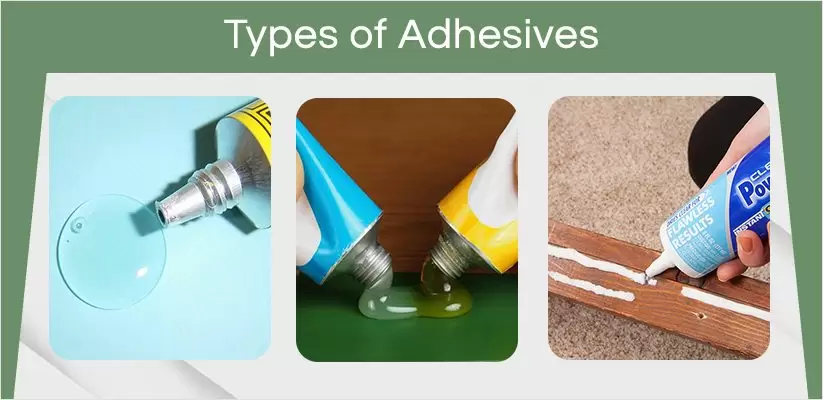What are Adhesives?
It is glue cement, paste, or mucilage is a non-metallic substance applied to one or both surfaces of the non-metallic substance that keeps them together using binding. There are various advantages of using it over other binding techniques like sewing, welding, or mechanical fastenings.
Post your Requirement
The use of this technique over other methods from the scientific point of view can bind with more efficiency and distribute the stress across the joint. Importantly, it is the most economical way of binding and presents a more significant aesthetic style in terms of style. They are either found naturally or are produced synthetically. There are several processes whereby they are made and have become an indispensable part of the economy.
It is a fact that no other product can be manufactured or old without the use of adhesives glues. An example of their being an integral part of the economy is the label on bottles of cold drink or cosmetics, the coating on automobiles, or any other product.
Types of Adhesives:
They are classified through adhesion. They are also differentiated based on them being reactive or non-reactive; this implies that the chemical reaction occurs while binding happens and hardens.
The chemical composition of the binding element also classifies it in different categories. Based on the origin of the manufacturing’s raw materials, it can be either natural or synthetic. Here are a few of their different types:
- White Craft Glue- it is the most common type and is commonly used for lightweight porous materials like cloth, cardboard, or crafts. It is low in toxin content and is water-based; thus, cleaning up after the work is simple. However, it should be left to dry, set, and cure completely. Even after binding care should be taken, it is not exposed to water or loosens the bind.
- Yellow Wood Glue- this is also water-based and is made of vinyl acetate polymers. It works well with wood and can be dirty and tricky to handle when in the uncured state. It is more rigid and dries out clear.
- Superglue or cyanoacrylate- it works very quickly to bind and can be used on a wide array of substances. It is required that the surfaces are well fitted with each other to bind well. When setting an acetone solvent, the wipe can help with cleaning, but once hard after curing, it cannot be dissolved. It is best suited for wood, metal, leather, glass, and plastic where tight line bond is required.
- Hot Glue- this type of binding is done with the help of a hot melt substance by pouring it with a glue gun. It can be used on both porous and non-porous surfaces and can bond uneven surfaces, even those filled with gaps. The hot fluid is best suited for surfaces that have texture and paint on them. They are apt for adding flowers or embellishments on the body, and here strength is not of prime importance.
- Pressure-sensitive Adhesives- there is available in sheets and dots used for a wide variety of projects on materials like glass, metal, plastic, and paper. The category has a wide variety of options like spray, fabric, Epoxy, polyurethane, and stick format.
Related Post: What are the disadvantages of adhesives?
Uses of Adhesive:
As there are several types of the category, depending on each type’s suitability for binding the two surfaces, it should be selected. Their prime use is to bind or join two surfaces together.
Adhesive glue for plastic – Plastic is used in many formats, and therefore the need to bind the plastic can arise. With the right type of Glue, even the plastic can be stacked to each other. Selecting the best one for plastic can be difficult as most of the types will either dissolve or not be able to bond well. Thus getting the right material to bind them is highly essential. However, before deciding the Glue, the type of plastic must be first ascertained. The type of plastic can be understood with the help of label on it.
Usually, its cyanoacrylate that helps in binding the plastic. It is water-resistant and sets within seconds of application, and it dries clear, leaving no sign of application. Another glue that can be of help is a clear liquid type. It works well with household things or toys made of plastic. If there are gaps in plastic that need to be filled, then its plastic bonder needs to be used. It has a unique acrylic formula that binds two surfaces to create a long-lasting and robust result in less than half an hour. It is water-resistant and takes 24 hours to cure.
Adhesive sealant spray is a type of spraying sealer that creates a durable rubber barrier to stop all leakage types in a few minutes of its application. It has a wicking action that reaches hard and deep areas without disassembling or removing the parts. It is used mostly in low-pressure leaks, fluid reservoirs, oil pans, plastics like PVC, and metal pipes. There is no requirement of liquid additive sealer that can result in swollen or internal seals causing damage to the materials on the surface that has been bind. Adhesive sealant glue is a silicone sealant that is in a liquid gel form. It has a chemical combination that differs from other types of Glue. As it is made of silicone, it provides high elasticity and stability both in high or low temperatures.
Where to Buy Adhesives?
It is important to understand that the above-discussed options and the types are available from many brands. As per your need, budget, and environmental condition of the area, select one. At, McCoyMart, there are the best options from multiple brands at the best price; thus, pick up the best-suited option for you.























Post A Comment